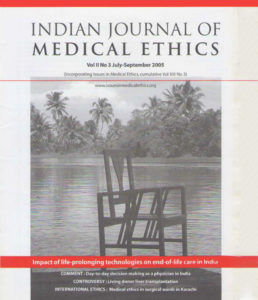
This issue contains a collection of articles on end-of-life care in India, In the editorials a neurosurgeon reflects on the impact of life-prolonging technologies in a society where people can go bankrupt in their efforts to bring there loved ones back to good health. A pulmonologist identifies some key issues in the care of terminally ill patients.A social scientist calls for rationing of health care and legalisation of physician assisted suicide and euthanasia. A US based medical professional describes his own painful experience in India. Another doctor describes by a hospice. The selected summary Discusses the controversy surrounding Terry Schiavo in the US, and Its implicatons for India.
In a comment, A US based surgeon reflects on ethical dilemmas, he faced when practising medicine in India, and how he resolved them. An Indian surgeon responds.
High technology medicine introduces new risks and new problem, living donor liver transplantation raises special concerns, including the fact that it poses risks to the donor. The Controversy section contains a statement by a patient’s relative, and the hospital’s reply.
How much do surgeons know about medical ethics, and how well do they practise it? In International Ethics, surgeons from Pakistan present the findings of a survey on knowledge, attitude and practice in two major hospitals.
Cover photograph courtesy: Nobhojit Roy
